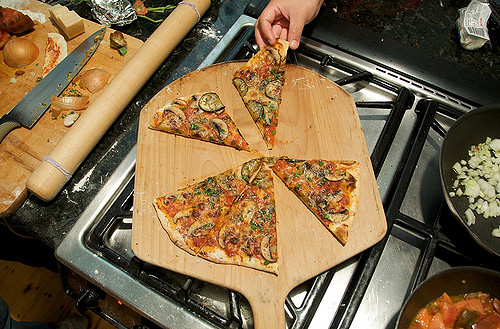
This makes enough dough for one medium-sized pizza with the crust rolled thin. You’ll probably want to multiply these quantities by the number of people you’re cooking for.
Weigh into a large bowl or container:
1 1/3 cups (185g) flour
1 teaspoon (6g) salt
1 tablespoon (9g) instant yeast
Using a spoon, mix together so that the salt and yeast are thoroughly distributed. Add:
½ cup (120 mL) water
Mix in the water using the spoon so that the flour and water are incorporated. Cover the bowl or container with plastic wrap and let it rest on the counter for six hours, preferably longer. When ready, transfer the dough to a floured cutting board and gently stretch the dough out, pushing it into either a rectangular or circular pizza shape from the center. For a more rustic crust, leave the edge thicker and handle it minimally to leave more air pockets in the dough. For a thinner crust, roll the dough out. Follow standard pizza making instructions from this point on.
You can mix the ingredients together at breakfast time, before running off to your day job or wherever, and the dough will be ready by the time you get home. The
glutenin
and
gliadin
proteins will slowly crosslink on their own.
Note:
If you want to experiment, order some sourdough yeast culture (which is actually a culture of both the well-known sourdough strain of yeast and the bacteria Lactobacillus). The ratio of yeast to bacteria in the dough will impact the flavor. You can control that ratio by letting the dough mature for some amount of time in the fridge, where yeast will multiply but bacteria won’t, and some amount of time at room temperature, where the bacteria will contribute flavors.